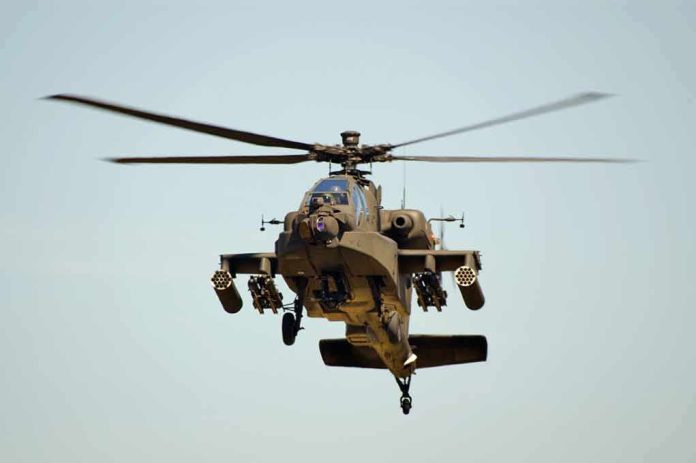
A new autonomous military drone, the U-Hawk, challenges traditional military strategies by eliminating the need for human pilots.
Story Highlights
- The UH-60L Black Hawk has been transformed into an autonomous utility drone, the U-Hawk.
- The U-Hawk’s cockpit has been replaced with cargo doors for logistical and air assault capabilities.
- First flight is expected in 2026, marking a significant step in autonomous military technology.
- This development reflects broader military trends towards reducing risk and enhancing capabilities.
Revolutionizing Military Aviation with the U-Hawk
Sikorsky, a subsidiary of Lockheed Martin, has unveiled the U-Hawk, an autonomous version of the iconic UH-60L Black Hawk helicopter. By removing the traditional cockpit and replacing it with cargo doors, the U-Hawk is designed to perform logistical and air assault operations without human involvement. This transformation, completed in just ten months, underscores a significant shift towards unmanned military systems.
Since its introduction in the late 1970s, the Black Hawk has been a staple of military aviation, known for its versatility and reliability. The U-Hawk builds on this legacy by incorporating cutting-edge autonomous technology, positioning itself as a critical asset for future military operations. This development comes as part of a broader trend in military strategy, emphasizing unmanned systems to enhance operational capabilities and reduce risks to personnel.
Key Stakeholders and Development Timeline
Sikorsky and Lockheed Martin have partnered with DARPA to bring the U-Hawk to life, with DARPA providing essential funding for integrating autonomous technology. This collaboration is part of a long-standing effort to innovate within the defense sector, aiming to expand product offerings and advance military capabilities. The U-Hawk was showcased at the Association of the United States Army exposition in 2025, highlighting its potential as a game-changing platform for logistics and air assaults.
The timeline for the U-Hawk’s development has been remarkably swift. DARPA began funding the project in 2024, and by 2025, the U-Hawk was presented to the public. The first flight is anticipated in 2026, marking a crucial milestone in the evolution of autonomous military technology.
Implications for Military Strategy and Defense Industry
The introduction of the U-Hawk is poised to have far-reaching impacts on military strategy and the defense industry. In the short term, it offers enhanced logistical capabilities and increased safety by minimizing human risk in dangerous environments. Long-term implications include a strategic shift towards more autonomous systems, potentially influencing geopolitical dynamics and leading to economic impacts within the defense sector.
Experts in the field view the U-Hawk as a cost-effective and efficient solution for modern military challenges. However, the development of autonomous military systems also raises ethical considerations, with some experts emphasizing their potential to save lives while others express caution. As the U-Hawk prepares to take its first flight, it stands as a testament to the evolving nature of military technology and the possibilities it holds for the future.
Sources:
Sikorsky Unveils Autonomous U-Hawk Drone
Lockheed Martin’s Official News on U-Hawk Development
Next Gen Defense’s Coverage on U-Hawk
Task and Purpose: Black Hawk Autonomous Helicopter







